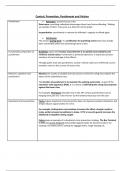Control, Prevention, Punishment and Victims
Punishment • Reduction- prevent future crime
Deterrence- punishing individuals discourages them from future offending. ‘Making
an example of them’ may serve as a deterrent to the public
Incapacitation- punishment to remove the offender’s capacity to offend again.
• Retribution
This means ‘paying back’. It is justification for punishing crimes that have already
been committed rather than preventing future crimes
Functionalist perspective on Durkheim argues the function of punishment is to uphold social solidarity and
punishment reinforce shared values. Punishment is primarily expressive. It expresses society’s
emotions of moral outrage at the offence.
Through public trials and punishment, society’s shared values are reaffirmed, and its
members come to feel a sense of moral unity
Marxism: capitalism and Marxists see society as divided into two classes in which the ruling class exploits the
punishment labour of the subordinate class.
The function of punishment is to maintain the existing social order. As part of the
repressive state apparatus (RSA), it is a means of defending the ruling class property
against the lower class
For example, Thompson describes how in the 18th century punishments such as
hanging were part of a ‘rule of terror’ by the landed aristocracy over the poor
Situational crime prevention Clarke argues situational crime prevention does not improve societies institutions, but
simply reduces opportunities for crime.
For example, locking doors and windows increases the effort a burglar needs to
make, while increased surveillance in shops- CCTV or security guards increases the
likelihood of shoplifters being caught.
Felson gives an example of a situational crime prevention strategy. The Bus Terminal
in NYC was poorly designed and provided opportunities for deviant conduct. For
example, the toilets were a setting for luggage thefts, rough sleeping etc.





